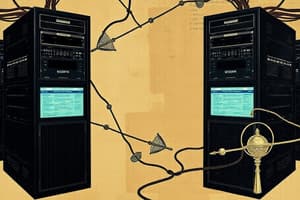Podcast
Questions and Answers
Which of the following is a primary function of a router in a network?
Which of the following is a primary function of a router in a network?
- Routing traffic between different networks. (correct)
- Connecting devices within the same network segment.
- Providing wireless access to network resources.
- Filtering network traffic based on MAC addresses.
What is the purpose of Spanning Tree Protocol (STP) in a network?
What is the purpose of Spanning Tree Protocol (STP) in a network?
- To provide redundancy for network routers.
- To prioritize different types of network traffic.
- To prevent network loops in a switched network. (correct)
- To increase bandwidth capacity on network links.
Which network device operates as a 'dummy switch,' forwarding all incoming packets to every connected device regardless of destination?
Which network device operates as a 'dummy switch,' forwarding all incoming packets to every connected device regardless of destination?
- Switch
- Router
- Hub (correct)
- Firewall
A network administrator needs to implement a solution that segments a network logically without physically separating the devices. Which technology achieves this?
A network administrator needs to implement a solution that segments a network logically without physically separating the devices. Which technology achieves this?
Which layer of the OSI model is responsible for establishing, managing, and terminating connections between applications?
Which layer of the OSI model is responsible for establishing, managing, and terminating connections between applications?
In the context of network communication, what does 'encapsulation' refer to?
In the context of network communication, what does 'encapsulation' refer to?
Which of the following is a characteristic of connection-oriented communication using TCP?
Which of the following is a characteristic of connection-oriented communication using TCP?
Which of the following best describes the function of a firewall in a network?
Which of the following best describes the function of a firewall in a network?
What is the primary difference between data rate and throughput in networking?
What is the primary difference between data rate and throughput in networking?
Which IEEE 802.11 standard supports the highest maximum data rate?
Which IEEE 802.11 standard supports the highest maximum data rate?
Which network type typically covers the largest geographical area?
Which network type typically covers the largest geographical area?
What is a key advantage of wired networks over wireless networks in terms of reliability?
What is a key advantage of wired networks over wireless networks in terms of reliability?
In half-duplex communication over Ethernet, which statement is true?
In half-duplex communication over Ethernet, which statement is true?
Which protocol is commonly used for packet tagging in VLANs?
Which protocol is commonly used for packet tagging in VLANs?
Which of the following is considered a network access point?
Which of the following is considered a network access point?
What is typically included in the student introduction during the course introduction?
What is typically included in the student introduction during the course introduction?
Which of the following is NOT typically covered under the 'Topics' section of the course outline?
Which of the following is NOT typically covered under the 'Topics' section of the course outline?
What components are generally included as networking components?
What components are generally included as networking components?
What is the typical weightage of the Class Practical Assignment in the total assessment?
What is the typical weightage of the Class Practical Assignment in the total assessment?
Which service is NOT typically associated with a server?
Which service is NOT typically associated with a server?
Which server type is responsible for authentication, authorization, and accounting?
Which server type is responsible for authentication, authorization, and accounting?
What is a primary function of a web server?
What is a primary function of a web server?
What is the key role of an FTP server in a network?
What is the key role of an FTP server in a network?
Bandwidth capacity is a crucial factor for servers. Why is bandwidth capacity important for servers?
Bandwidth capacity is a crucial factor for servers. Why is bandwidth capacity important for servers?
Which of the following best describes the role of a router in network communication?
Which of the following best describes the role of a router in network communication?
What is the main function of an access list in a router?
What is the main function of an access list in a router?
In a network, what does it mean when each port of a router has another broadcast domain?
In a network, what does it mean when each port of a router has another broadcast domain?
Compared to a router, how does a switch handle network traffic within a specific network?
Compared to a router, how does a switch handle network traffic within a specific network?
What is the typical bandwidth capacity of each port on a hub?
What is the typical bandwidth capacity of each port on a hub?
What is the main drawback of using a hub in a modern network?
What is the main drawback of using a hub in a modern network?
What best describes the function of an access point in a network?
What best describes the function of an access point in a network?
What role does a firewall play in network communication?
What role does a firewall play in network communication?
How does a firewall act as a router?
How does a firewall act as a router?
What characterizes a peer-to-peer network compared to a client-server network?
What characterizes a peer-to-peer network compared to a client-server network?
Flashcards
What is a Router?
What is a Router?
Network devices that forwards data packets between computer networks.
What is a Switch?
What is a Switch?
A network device that connects devices within the same network.
What is Spanning Tree Protocol?
What is Spanning Tree Protocol?
A network device that prevents loops, maintains backup connections.
What does Switching do?
What does Switching do?
Signup and view all the flashcards
What is a Hub?
What is a Hub?
Signup and view all the flashcards
What is an Access Point?
What is an Access Point?
Signup and view all the flashcards
What is a Firewall?
What is a Firewall?
Signup and view all the flashcards
Application Layer
Application Layer
Signup and view all the flashcards
Presentation Layer
Presentation Layer
Signup and view all the flashcards
Session Layer
Session Layer
Signup and view all the flashcards
Transport Layer
Transport Layer
Signup and view all the flashcards
Network Layer
Network Layer
Signup and view all the flashcards
Data Link Layer
Data Link Layer
Signup and view all the flashcards
Physical Layer
Physical Layer
Signup and view all the flashcards
List the OSI Model Layers
List the OSI Model Layers
Signup and view all the flashcards
What is Encapsulation?
What is Encapsulation?
Signup and view all the flashcards
What is De-encapsulation?
What is De-encapsulation?
Signup and view all the flashcards
What is Connectionless Protocol?
What is Connectionless Protocol?
Signup and view all the flashcards
What is Connection-oriented Protocol?
What is Connection-oriented Protocol?
Signup and view all the flashcards
What is Data Rate?
What is Data Rate?
Signup and view all the flashcards
What is Throughput?
What is Throughput?
Signup and view all the flashcards
What are examples of Wired Networks?
What are examples of Wired Networks?
Signup and view all the flashcards
What are examples of Wireless Networks?
What are examples of Wireless Networks?
Signup and view all the flashcards
What is PAN?
What is PAN?
Signup and view all the flashcards
What is LAN?
What is LAN?
Signup and view all the flashcards
What is MAN?
What is MAN?
Signup and view all the flashcards
What is WAN?
What is WAN?
Signup and view all the flashcards
What is full Duplex?
What is full Duplex?
Signup and view all the flashcards
What is half Duplex?
What is half Duplex?
Signup and view all the flashcards
What are VLANs?
What are VLANs?
Signup and view all the flashcards
Study Notes
Introductie
- Vandana G. Bandhoesingh BSc, MBA is the instructor.
- Students will introduce themselves by stating name, age, work and personal technical interests.
Course Outline
- Topics covered include networking components, TCP/UDP/IP network protocols, subnetting, and basic network troubleshooting.
- Assessment consist of 25 multiple-choice questions (70%) and a class practical assignment (30%) in English.
Network Components - Servers
- Servers are software running on robust hardware with enough capacity.
- Servers coordinate multiple client requests.
- Server requirements include bandwidth capacity, storage, and physical or virtual infrastructure.
- Examples of servers:
- Web servers host websites.
- Email servers facilitate sending and receiving emails through IMAP, POP, or SMTP.
- FTP servers handle file transfer protocols and file sharing through a LAN intranet.
- Identity servers (AAA, TACACS) handle authentication, authorization, and accounting purposes.
- Securing servers is important.
Network Basic Elements
- Key elements of a network include routers, firewalls, switches/hubs, and wireless modems.
Network Components - Router
- A router connects several network components to each other.
- Routers route traffic from one network to another.
- Routers learn about neighbors.
- Access lists can be created.
- Access lists include whitelists and blacklists.
- Each port on a router has another broadcast domain.
Network Components - Switch
- A switch connects devices from one specific network to each other.
- Switches send traffic to specific devices connected to a specific port/interface.
- The bandwidth of each port is limited to 100Mbps.
- Traffic can be defined through VLANs.
- A switch creates a redundant network through Spanning Tree.
Network Components - Switch - Spanning Tree
- Spanning Tree decides the best path for data transmission which is the shortest path with less delay.
- Spanning Tree prevents loops in a network, while maintaining backup connections within.
Switching - Keeping Track of Hosts
- A switch learns MAC addresses and maps them to an IP address.
- MAC addresses are unique physical addresses of a device.
- A switch keeps track of an ARP table per port.
Network Components - Hub
- A hub is a basic switch that sends traffic to everyone within that network.
- The bandwidth capacity of 100Mbps is distributed to all connections.
- Hubs forward all incoming packets to everyone in the network, regardless of the intended recipient.
- Hubs cause a lot of unnecessary traffic and load on the network.
Network Components - Access Points
- An access point is a wireless router that connects several hosts.
Network Components - Firewall
- The firewall establishes a barrier between a trusted internal network and an untrusted external network, such as the Internet.
- Firewalls act as a router, connecting the external network with the internal network.
- Access rules are created by Firewalls.
- Firewalls monitor incoming and outgoing traffic based on security rules.
Client - Server vs Peer-to-Peer
- A diagram visually outlines the setup for both client and peer networks.
OSI and Other Network Models
- The OSI (Open Source Interconnection) model is a seven-layer model.
- Layer 7 - Application Layer: End user layer for programs that open or create content.
- Functions include resource sharing, remote file access, remote printer access, directory services, and network management.
- The central device or protocol used is SMTP.
- Layer 6 - Presentation Layer: Syntax layer that encrypts and decrypts.
- Functions include Character code translation, data conversion, data compression, data encryption, and character set translation.
- Common protocols include JPEG/ASCII, EBDIC/TIFF/GIF, and PICT.
- Layer 5 - Session Layer: Synchronizes and sends to ports.
- Session establishment, maintenance, termination, support, security, name recognition, and logging.
- Common Protocols: RPC/SQL/NFS, NetBIOS Names
- Layer 4 - Transport Layer: TCP (Host to Host), and flow control.
- Message segmentation, acknowledgement, message traffic control, and session multiplexing. -TCP/SPX/UDP
- Layer 3 - Network Layer: Packets (Letters), contains IP addresses.
- Routing, subnet traffic control, frame fragmentation, and logical-physical address mapping, and subnet usage accounting.
- Routers
- Protocols: IP/IPX/ICMP
- Layer 2 - Data Link Layer: Frames ("envelopes") contains MAC address.
- Functions: Establishes and terminates logical links between nodes, ensures frame traffic control, sequencing, acknowledgment, delimiting, error checking, and controls media access.
- This layer is the most related to Switch, Bridge, WAP, PPPSLIP, Land Based Layers
- Layer 1 - Physical Layer: concern with transmission and reception of raw bits.
- Data encoding, physical medium attachment, and transmission technique.
- Cables, Hubs
Communication on the Network
- A data diagram represents communication on the network.
Packet Details
- A visual diagram outlines the details of TCP/IP packets.
TCP Three-Way Handshake
- A three-way handshake establishes a connection between client and server.
Encapsulation and De-encapsulation
- Data from the APPLICATIE layer (layer 5) such as web browsing data, receives the HTTP header and this is called "DATA".
- Data arrives at the TRANSPORT layer (layer 4), a TCP header is added (ENCAPSULATED)
- The packets are now called SEGMENTS.
- With UDP packets, they would be called DATAGRAMMEN.
- Data reaches the NETWORK layer (layer 3), the IP protocol works and the IP header is added.
- The packets are then called PACKETS
- Packets arrive at layer 2, the DATA LINK layer and are called FRAMES.
- A data link header and trailer is added.
- Examples include Ethernet, Frame-relay, ATM.
- They arrive on the PHYSICAL layer, layer 1 where the frames are changed into BITS to be sent.
Connectionless vs Connection-Oriented Data Communication
- Connectionless (UDP):
- Data is sent without setup or breakdown of the connection.
- Connection-oriented (TCP):
- A connection is first made, maintained, and then broken down.
- Possible scenarios:
- Without Virtual Circuit:
- TCP on the internet - Packets are broadly routed but tracked.
- With Virtual Circuit:
- Packets follow the same route.
- Without Virtual Circuit:
- Tthree-way handshake is something to investigate further.
Bandwidth; Data Rate and Throughput
- Data Rate is the speed at which data is transmitted.
- Data Rate comes in kilobits per second (kbps) or megabits per second (Mbps).
- Throughput: volume of data consumed, such as mobile data plan usage.
Physical Layer
- Wired Network:
- Uses copper Cat 5e or Cat 6 cables.
- May use fiber optic cables.
- Wireless Network:
- Outdoor cellular technologies include GSM, MicrowaveWiMAX, LTE, Satellite, etc.
- Indoor wireless technologies are utilized, such as Wireless LAN (WiFi) or Bluetooth.
Types of Networks
- A visual graph with the differences in networks (WAN, PAN, LAN, MAN)
Types of Wireless Networks
- Wireless tech types based on range: WWAN, WMAN, WLAN, WPAN
Physical Layer - Wired vs Wireless
- A table compares wired and wireless networks.
- Provides a comparison of specifications, wired network and wireless network.
- Speed of operation: wired is higher, but wireless tech is catching up.
- System Bandwidth: higher in wired, but lower in wireless, as Frequency Spectrum is scarce.
- Cost: less in wired. More for wireless due to stations, routers and adapters.
- Mobility: limited in wired, not limited in wireless.
- Transmission medium: copper wires, optical fiber cables, ethernet VS radiowaves
Wired vs Wireless
- A table compares wired network with a wireless network in relation to Interference, QoS and Reliability.
- Channel Interference is more susceptible to interference in a wireless setting.
- QoS (Quality of Service) is better with wired networks.
- Reliability - failure of a router in the wired network will affect the entire network.
Data Link Layer - Switchports
- Ethernet ports support:
- Half Duplex: Transmitting data in one direction at a time.
- Full Duplex: Transmitting data in both directions simultaneously.
- 10 Mbps half/full duplex.
- 100 Mbps fast ethernet.
- 1000 Mbps (1Gb).
Data Link Layer - VLANs
- Virtual LANs split networks on a logical/software/configuration level, but remain physically connected to one node/wire.
- VLANs typically use IEEE 802.1Q protocol for packet-tagging.
- S1 and S3 each have both red and blue ports and the switch network S1-S4 deliver traffic when source and destination ports share the same color.
- Red packets can be forwarded to the blue VLAN only only by passing through the router R, entering R's red port and leaving its blue port.
- R may apply firewall rules to restrict red–blue traffic.
- When the source and destination ports are on the same switch, nothing needs to be added to the packet
- Switch can track the ports
- Swith-to-switch traffic be tagged with source traffic in order to be delivered
Studying That Suits You
Use AI to generate personalized quizzes and flashcards to suit your learning preferences.




